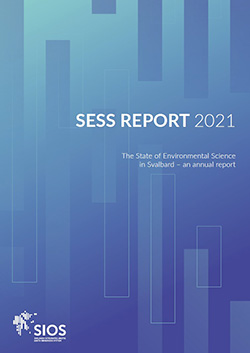The State of Environmental Science in Svalbard (SESS) report 2021 has been released during the SIOS Polar Night Week in Longyearbyen, 24 January 2021. It is the fourth issue of an annual series of reports published by SIOS.
In the three first years of the SESS report, SIOS has received more than 140 recommendations on how to improve the observing system for Earth system science in Svalbard. In 2021 it was time to consolidate and implement these recommendations. Therefore, the SESS report 2021 is the first report focusing on chapters already published in previous SESS reports.
The SESS report is published in two versions:
SESS report 2021 – Summary for Stakeholders
Paper prints can be ordered from information@sios-svalbard.org
ISSN 2535-6313 (printed)
ISSN 2535-6615 (pdf)
ISBN 978-82-93871-04-0 (printed, stapled)
ISBN 978-82-93871-05-7 (pdf)
Citation: please cite the full report
SESS report 2021 – Full report
ISSN 2535-809X (printed)
ISSN 2535-6321 (pdf)
ISBN 978-82-93871-02-6 (printed, stapled)
ISBN 978-82-93871-03-3 (pdf)
Citation of entire report: Feldner J, Hübner C, Lihavainen H, Neuber R, Zaborska A (eds) 2022: SESS report 2021, Svalbard Integrated Arctic Earth Observing System, Longyearbyen. https://sios-svalbard.org/SESS_Issue4
Citation of chapters in report: All authors (2021) Title of chapter. In: Feldner J et al (eds) SESS report 2021, Svalbard Integrated Arctic Earth Observing System, Longyearbyen, pp xx-xx. DOI-link of chapter
Download scientific chapters separately:
Chapter 1: iMOP II
Cottier F, Skogseth R, David D, De Rovere F, Vogedes D, Daase M, Berge J (2022) Temperature and salinity time series in Svalbard fjords – ‘Integrated Marine Observatory Partnership.
https://doi.org/10.5281/zenodo.5751717
Chapter 2: COAT
Pedersen ÅØ, Albon S, Beumer LT, Fuglei E, Isaksen K, Liston G, Jepsen JU, Madsen J, Mosbacher J, Paulsen IMG, Pedersen ST, Ravolainen VT, Reinking AK, Soininen EM, Stien A, Stien J, van der Wal R, Yoccoz NG, Ims RA (2022) Climate-Ecological Observatory for Arctic Tundra (COAT) – Adaptive system for long-term terrestrial monitoring.
https://doi.org/10.5281/zenodo.5751761
Chapter 3: PASSES 2
Salzano R, Aalstad K, Cerrato R, Luks B, Salvatori R, Westermann S (2022) Improving terrestrial photography applications on snow cover in Svalbard with satellite remote sensing imagery.
https://doi.org/10.5281/zenodo.5751867
Chapter 4: EXAODEP-2020
Petkov BH, Vitale V, Di Carlo P, Hansen GH, Svendby TM, Laska K, Sobolewski PS, Solomatnikova A, Pavlova K, Johnsen B, Posyniak MA, Elster J, Mazzola M, Lupi A, Verazzo G (2022) The extreme Arctic ozone depletion in 2020 as was observed from Svalbard.
https://doi.org/10.5281/zenodo.5751922
Chapter 5: UAV Svalbard Update
Hann R, Betlem P, Deja K, Hartvich F, Jonassen M, Lampert A, Laska M, Sobota I, Storvold R, Zagorski P (2022) Update to Scientific Applications of Unmanned Vehicles in Svalbard.
https://doi.org/10.5281/zenodo.5751959
- Scientific literature that utilises unmanned vehicles in Svalbard: https://sios-svalbard.org/UAV_Svalbard
Chapter 6: SCD
Matero I, Ignatiuk D, Godøy Ø, Luks B, Neuber R, Vitale V, Jawak S, Hübner C, Jennings I, Lihavainen H (2022) SIOS Core Data.
https://doi.org/10.5281/zenodo.5751970




























